With his sharply featured face, high forehead and low-lying eyes, German film actor Bernhard Goetzke (1884–1964) was one of the impressive stars of the silent films of Fritz Lang. He appeared in 130 films between 1917 and 1961.
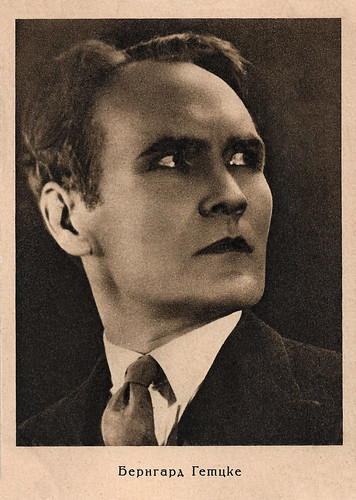
Russian postcard by Goznak, Moscow, Serie no. 14, no. A 29871, 1929. The card was issued in an edition of 15.000 copies. The price was 10 Kop.
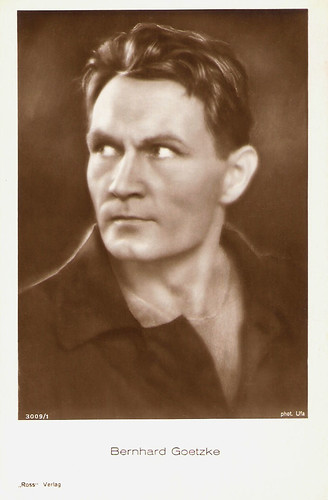
German postcard by Ross Verlag, no. 3009/1, 1928-1929. Photo: Ufa.

German postcard by Ross Verlag, no. 675/4. Photo: Decla-Ufa-Film. Caption: Kriemhild (Margarethe Schön) gives Volkert (Bernhard Goetzke) Siegfried's cloak. Still for Die Nibelungen, II: Kriemhilds Rache (Fritz Lang, 1924).
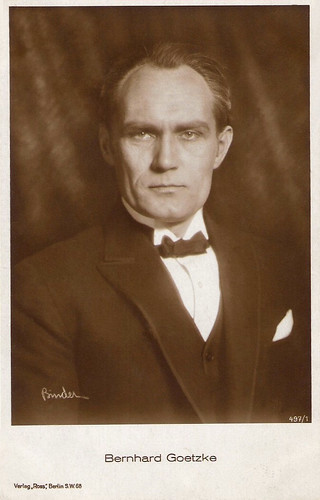
German postcard by Ross Verlag, no. 497/1, 1919-1924. Photo: Alex Binder.
Bernhard Goetzke was born in Danzig, Germany (now Gdańsk, Poland) in 1884. After private training as an actor, he performed in theatres in Düsseldorf, Hagen, and Dresden. During the First World War, he went to Berlin. There he played on many stages and worked under the famous director Max Reinhardt. Goetzke started his film career in the 1910s. In 1917 he appeared with Conrad Veidt in the eerie dream-like Furcht/Fear (Robert Wiene, 1917).
This was soon followed by leading roles in the mystery Die Japanerin/The Japanese Woman (Ewald André Dupont, 1919) opposite Ria Jende, Anita Jo (Dimitri Buchowetzki, 1919) featuring Hanni Weisse, and Zwischen Tod und Leben/Between Life and Death (Arthur Wellin, 1919) with Alexander Moissi.
Goetzke had a supporting part in the international box office hit Madame DuBarry (Ernst Lubitsch, 1919) starring Pola Negri.
A second highlight was Die Brüder Karamasoff/The Brothers Karamazov (Carl Froelich, 1921), the first film version of Fyodor Dostoevsky’s famous novel. He played Iwan Karamazov. Emil Jannings and Fritz Kortner played his (young and older) brother, the murderer Dimitri.
Another huge success was the two-part adventure epic Das indische Grabmal/The Indian Tomb (Joe May, 1921), in which Goetzke appeared as a sinister Yogi opposite Olaf Fönss and Mia May. His sharply featured face, high forehead and low-lying eyes as well as his long, slim form made him one of the most impressive appearances of the silent cinema.

Spanish collector card by Chocolat Imperiale, Barcelona, episode 7, no. 7. Photo: Distr. J. Gurgui, Barcelona / May Film. Bernhard Goetzke (left) in the German silent film serial Die Herrin der Welt/ The Mistress of the World (Joe May, 1919). The Spanish film title was La dueñá del mundo. The man on the right could be actor Paul Hansen, who plays the engineer Allan Stanley. He is the main male actor in episode 7.

German postcard by Ross Verlag, no. 672/4. Photo: Decla-Ufa-Film. Bernhard Goetzke as Volker von Alzey, the bard in Die Nibelungen (Fritz Lang, 1924). The costumes and sets of the film were inspired by Carl Otto Czeschka's book illustrations (1909) of 'Die Nibelungen'.
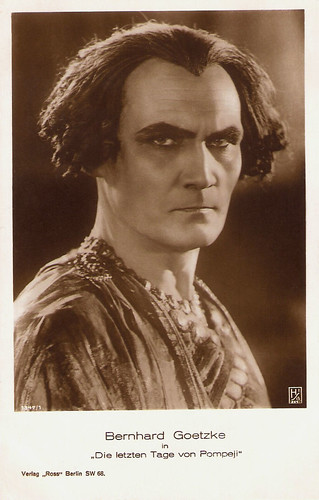
German postcard by Ross Verlag, no. 1347/1. Photo: Hisa Film-Vertrieb. Bernhard Goetzke as the evil Egyptian priest Arbaces in the silent epic Gli ultimi giorni di Pompei/The Last Days of Pompeii (Carmine Gallone, Amleto Palermi, 1926).

Italian postcard by C. Chierichetti, Milano. Photo: Grandi Films, Roma. Publicity still for the Italian-German silent film Gli ultimi giorni di Pompei/The Last Days of Pompeii (Amleto Palermi, Carmine Gallone, 1926). Calenus (Emilio Ghione) tries to blackmail Arbaces (Bernhard Goetzke). Arbaces leads him to his treasury.
Bernhard Goetzke’s most notable film performance was his title role of Death in Fritz Lang’s Der müde Tod/Destiny (Fritz Lang, 1921). He worked again for Lang in Dr. Mabuse, der Spieler/Dr. Mabuse: The Gambler (Fritz Lang, 1922), the first in Lang's series of thrillers around the criminal mastermind Dr. Mabuse (Rudolph Klein Rogge). Goetzke also played Volker von Alzey, the Bard, in Lang‘s epic fantasy Die Nibelungen (Fritz Lang, 1924).
Then he played the leading role of engineer Kramer in Gerhard Lamprecht‘s social drama Die Verrufenen/Slums of Berlin (Gerhard Lamprecht, 1925) with Aud Egede Nissen, and he also starred in the sequel Die Unehelichen/Children of No Importance (Gerhard Lamprecht, 1926).
In that same year, Alfred Hitchcock directed him in the leading role of his romantic thriller The Mountain Eagle (1926), which was shot in München (Munich). He played a Kentucky shopkeeper in love with a teacher (Nita Naldi). When she refuses him, he accuses her of molesting his mentally ill son. Hitchcock also wrote the drama Die Prinzessin und der Geiger/The Blackguard (Graham Cutts, 1925) with Goetzke and in the title role Walter Rilla.
In Italy, Goetzke played in the historical epic Gli ultimi giorni di Pompeii/The Last Days of Pompeii (Carmine Gallone, Amleto Palermi, 1926) with Victor Varconi. In France, he co-starred in the crime film Vivre/To Live (Robert Boudrioz, 1928) with Elmire Vautier. In France, he also played Father Faria in a silent adaptation of Alexandre Dumas Père’s Monte Cristo (Henri Fescourt, 1929) starring Jean Angelo.
He had his last leading role in Salamandra/Salamander (Grigori Roshal, 1929), one of the first German-Soviet co-productions. It was a Socialist Realist distortion of Dr. Paul Kammerer's experiments in the inheritance of acquired character(istic)s: the conjecture that certain changes which the environment produces in an individual may spontaneously appear in the next generation.
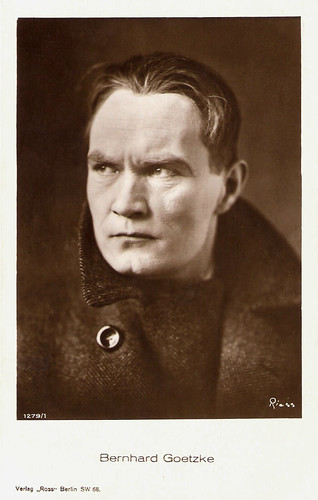
German postcard by Ross Verlag, no. 1279/1, 1927-1928. Photo: Riess.
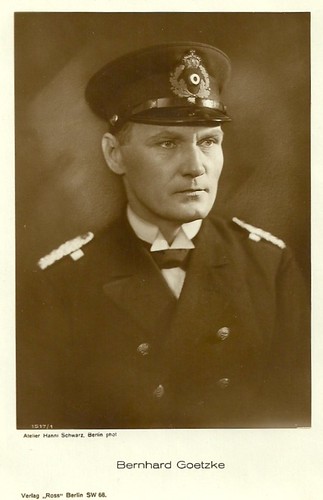
German postcard by Ross Verlag, no. 1517/1, 1927-1928. Photo: Atelier Hanns Schwarz.
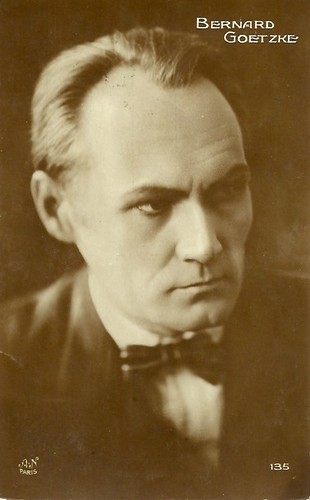
French postcard by A. N. (A. Noyer), Paris, no. 135.
When the sound film arrived, Bernhard Goetzke joined the fate of many of his colleagues and his film career went into decline. During the sound era, he only appeared in supporting roles. In the interesting Sci-Fi film Alraune/Daughter of Evil (Richard Oswald, 1930), he played one of the men who fell for the vamp Alraune, played by Brigitte Helm. In this sound version, Helm gives a different interpretation of the same part she had in the silent version two years earlier. She not only portrays Alraune, the artificially created girl who brings down men by the dozen but also her mother, a prostitute who agrees to take part in an experiment of artificial insemination.
Goetzke reunited with his former director Lamprecht and co-star Aud Egede Nissen for Zwischen Nacht und Morgen/Between Night and Dawn (Gerhard Lamprecht, 1931), but his role was only a minor one. In Finland, he played his last lead role as an old hunter in the drama Erämaan turvissa (Kalle Kaarna, Friedrich von Maydell, 1931). From then he played supporting or bit parts in dozens of run-of-the-mill films.
Among the more interesting films are the Jules Verne adaptation Der Kurier des Zaren/The Czar's Courier (Richard Eichberg, 1936) starring Adolph Wohlbrück (aka Anton Walbrook) as Lt. Michael Strogoff, and the pro-Irish propaganda film Der Fuchs von Glenarvon/The Fox of Glenarvon (Max W. Kimmich, 1941) with Olga Tschechova. He also played a small part in the notorious propaganda film Jus Süss/Jew Süss (Veit Harlan, 1941). His roles at the time were so small that his performances sometimes were not even credited.
After the war, Goetzke only appeared in two films of the East-German DEFA studio, as a poor farmer in the classic children’s fantasy Das kalte Herz/The Heart of Stone (Paul Verhoeven, 1950) with Lutz Moik, and as a priest in the biography Semmelweis - Retter der Mütter/Dr. Semmelweis (Georg C. Klaren, 1950).
He focused on his stage career, and till his death, he was an ensemble member of the Staatlichen Schauspielbühnen Westberlins (the State Theatres of West Berlin). His final screen appearance was a bit role in the TV film Elisabeth von England/Elizabeth of England (Hanns Korngiebel, 1961) featuring Elisabeth Flickenschildt. Bernhard Goetzke died in 1964 in West-Berlin. He was 80.
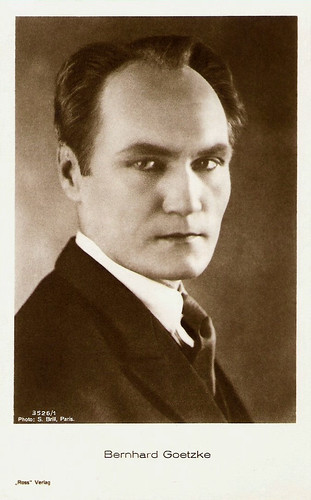
German postcard by Ross Verlag, no. 3526/1, 1928-1929. Photo: S. Brill, Paris.
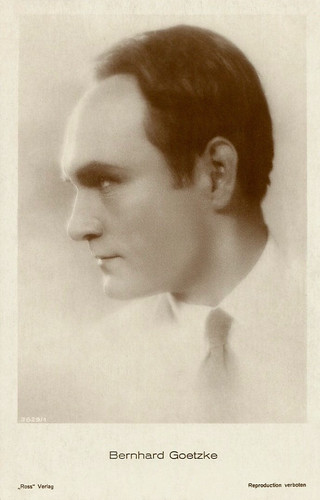
German postcard by Ross Verlag, no. 3629/1, 1928-1929.
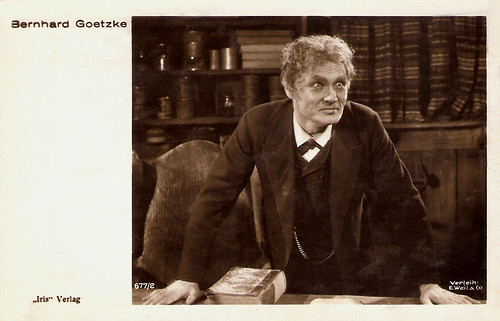
Austrian postcard by Iris Verlag, no. 677/2. Photo: Verleih E. Weil & Co.
Sources: Volker Wachter (DEFA Filmsterne), Wikipedia (English and German), and IMDb.
This post was last updated on 12 June 2024.

Russian postcard by Goznak, Moscow, Serie no. 14, no. A 29871, 1929. The card was issued in an edition of 15.000 copies. The price was 10 Kop.

German postcard by Ross Verlag, no. 3009/1, 1928-1929. Photo: Ufa.

German postcard by Ross Verlag, no. 675/4. Photo: Decla-Ufa-Film. Caption: Kriemhild (Margarethe Schön) gives Volkert (Bernhard Goetzke) Siegfried's cloak. Still for Die Nibelungen, II: Kriemhilds Rache (Fritz Lang, 1924).

German postcard by Ross Verlag, no. 497/1, 1919-1924. Photo: Alex Binder.
Ernst Lubitsch
Bernhard Goetzke was born in Danzig, Germany (now Gdańsk, Poland) in 1884. After private training as an actor, he performed in theatres in Düsseldorf, Hagen, and Dresden. During the First World War, he went to Berlin. There he played on many stages and worked under the famous director Max Reinhardt. Goetzke started his film career in the 1910s. In 1917 he appeared with Conrad Veidt in the eerie dream-like Furcht/Fear (Robert Wiene, 1917).
This was soon followed by leading roles in the mystery Die Japanerin/The Japanese Woman (Ewald André Dupont, 1919) opposite Ria Jende, Anita Jo (Dimitri Buchowetzki, 1919) featuring Hanni Weisse, and Zwischen Tod und Leben/Between Life and Death (Arthur Wellin, 1919) with Alexander Moissi.
Goetzke had a supporting part in the international box office hit Madame DuBarry (Ernst Lubitsch, 1919) starring Pola Negri.
A second highlight was Die Brüder Karamasoff/The Brothers Karamazov (Carl Froelich, 1921), the first film version of Fyodor Dostoevsky’s famous novel. He played Iwan Karamazov. Emil Jannings and Fritz Kortner played his (young and older) brother, the murderer Dimitri.
Another huge success was the two-part adventure epic Das indische Grabmal/The Indian Tomb (Joe May, 1921), in which Goetzke appeared as a sinister Yogi opposite Olaf Fönss and Mia May. His sharply featured face, high forehead and low-lying eyes as well as his long, slim form made him one of the most impressive appearances of the silent cinema.

Spanish collector card by Chocolat Imperiale, Barcelona, episode 7, no. 7. Photo: Distr. J. Gurgui, Barcelona / May Film. Bernhard Goetzke (left) in the German silent film serial Die Herrin der Welt/ The Mistress of the World (Joe May, 1919). The Spanish film title was La dueñá del mundo. The man on the right could be actor Paul Hansen, who plays the engineer Allan Stanley. He is the main male actor in episode 7.

German postcard by Ross Verlag, no. 672/4. Photo: Decla-Ufa-Film. Bernhard Goetzke as Volker von Alzey, the bard in Die Nibelungen (Fritz Lang, 1924). The costumes and sets of the film were inspired by Carl Otto Czeschka's book illustrations (1909) of 'Die Nibelungen'.

German postcard by Ross Verlag, no. 1347/1. Photo: Hisa Film-Vertrieb. Bernhard Goetzke as the evil Egyptian priest Arbaces in the silent epic Gli ultimi giorni di Pompei/The Last Days of Pompeii (Carmine Gallone, Amleto Palermi, 1926).

Italian postcard by C. Chierichetti, Milano. Photo: Grandi Films, Roma. Publicity still for the Italian-German silent film Gli ultimi giorni di Pompei/The Last Days of Pompeii (Amleto Palermi, Carmine Gallone, 1926). Calenus (Emilio Ghione) tries to blackmail Arbaces (Bernhard Goetzke). Arbaces leads him to his treasury.
Alfred Hitchcock
Bernhard Goetzke’s most notable film performance was his title role of Death in Fritz Lang’s Der müde Tod/Destiny (Fritz Lang, 1921). He worked again for Lang in Dr. Mabuse, der Spieler/Dr. Mabuse: The Gambler (Fritz Lang, 1922), the first in Lang's series of thrillers around the criminal mastermind Dr. Mabuse (Rudolph Klein Rogge). Goetzke also played Volker von Alzey, the Bard, in Lang‘s epic fantasy Die Nibelungen (Fritz Lang, 1924).
Then he played the leading role of engineer Kramer in Gerhard Lamprecht‘s social drama Die Verrufenen/Slums of Berlin (Gerhard Lamprecht, 1925) with Aud Egede Nissen, and he also starred in the sequel Die Unehelichen/Children of No Importance (Gerhard Lamprecht, 1926).
In that same year, Alfred Hitchcock directed him in the leading role of his romantic thriller The Mountain Eagle (1926), which was shot in München (Munich). He played a Kentucky shopkeeper in love with a teacher (Nita Naldi). When she refuses him, he accuses her of molesting his mentally ill son. Hitchcock also wrote the drama Die Prinzessin und der Geiger/The Blackguard (Graham Cutts, 1925) with Goetzke and in the title role Walter Rilla.
In Italy, Goetzke played in the historical epic Gli ultimi giorni di Pompeii/The Last Days of Pompeii (Carmine Gallone, Amleto Palermi, 1926) with Victor Varconi. In France, he co-starred in the crime film Vivre/To Live (Robert Boudrioz, 1928) with Elmire Vautier. In France, he also played Father Faria in a silent adaptation of Alexandre Dumas Père’s Monte Cristo (Henri Fescourt, 1929) starring Jean Angelo.
He had his last leading role in Salamandra/Salamander (Grigori Roshal, 1929), one of the first German-Soviet co-productions. It was a Socialist Realist distortion of Dr. Paul Kammerer's experiments in the inheritance of acquired character(istic)s: the conjecture that certain changes which the environment produces in an individual may spontaneously appear in the next generation.

German postcard by Ross Verlag, no. 1279/1, 1927-1928. Photo: Riess.

German postcard by Ross Verlag, no. 1517/1, 1927-1928. Photo: Atelier Hanns Schwarz.

French postcard by A. N. (A. Noyer), Paris, no. 135.
Alraune
When the sound film arrived, Bernhard Goetzke joined the fate of many of his colleagues and his film career went into decline. During the sound era, he only appeared in supporting roles. In the interesting Sci-Fi film Alraune/Daughter of Evil (Richard Oswald, 1930), he played one of the men who fell for the vamp Alraune, played by Brigitte Helm. In this sound version, Helm gives a different interpretation of the same part she had in the silent version two years earlier. She not only portrays Alraune, the artificially created girl who brings down men by the dozen but also her mother, a prostitute who agrees to take part in an experiment of artificial insemination.
Goetzke reunited with his former director Lamprecht and co-star Aud Egede Nissen for Zwischen Nacht und Morgen/Between Night and Dawn (Gerhard Lamprecht, 1931), but his role was only a minor one. In Finland, he played his last lead role as an old hunter in the drama Erämaan turvissa (Kalle Kaarna, Friedrich von Maydell, 1931). From then he played supporting or bit parts in dozens of run-of-the-mill films.
Among the more interesting films are the Jules Verne adaptation Der Kurier des Zaren/The Czar's Courier (Richard Eichberg, 1936) starring Adolph Wohlbrück (aka Anton Walbrook) as Lt. Michael Strogoff, and the pro-Irish propaganda film Der Fuchs von Glenarvon/The Fox of Glenarvon (Max W. Kimmich, 1941) with Olga Tschechova. He also played a small part in the notorious propaganda film Jus Süss/Jew Süss (Veit Harlan, 1941). His roles at the time were so small that his performances sometimes were not even credited.
After the war, Goetzke only appeared in two films of the East-German DEFA studio, as a poor farmer in the classic children’s fantasy Das kalte Herz/The Heart of Stone (Paul Verhoeven, 1950) with Lutz Moik, and as a priest in the biography Semmelweis - Retter der Mütter/Dr. Semmelweis (Georg C. Klaren, 1950).
He focused on his stage career, and till his death, he was an ensemble member of the Staatlichen Schauspielbühnen Westberlins (the State Theatres of West Berlin). His final screen appearance was a bit role in the TV film Elisabeth von England/Elizabeth of England (Hanns Korngiebel, 1961) featuring Elisabeth Flickenschildt. Bernhard Goetzke died in 1964 in West-Berlin. He was 80.

German postcard by Ross Verlag, no. 3526/1, 1928-1929. Photo: S. Brill, Paris.

German postcard by Ross Verlag, no. 3629/1, 1928-1929.

Austrian postcard by Iris Verlag, no. 677/2. Photo: Verleih E. Weil & Co.
Sources: Volker Wachter (DEFA Filmsterne), Wikipedia (English and German), and IMDb.
This post was last updated on 12 June 2024.
No comments:
Post a Comment